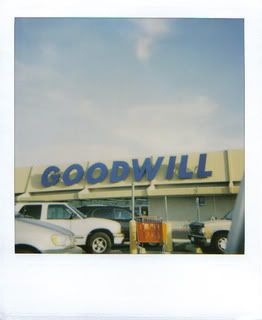The weather here is ba-nanas. Yes, I realize 175239064198 billion people are bitching about the dangerously cold temperatures on Twitter, blogs and Facebook right now. I'm far from the only one suffering. But it's bad here in Dallas. Record-setting bad. I feel like any minute Dennis Quaid is going to burst through my front door with snowshoes strapped to his feet and a sled trailing behind him, arriving to rescue Jake Gyllenhall and I as we're burning decrepit library books for heat and tanker trucks drift down a nearly frozen First Avenue behind us.
So I'm thankful that today is Thrifting 101 Thursday, and I have an excuse to avoid thinking about the weather (and posing for pics outside. Ain't gonna happen, folks.)
Last week I began my Thrifting 101 series with some basic tips for thrift store newbies and those intimidated by the squick factor. Today I'm going to focus on advice regarding how one should shop at a thrift store. I received quite a few emails regarding how overwhelming it can be just walking into a thrift store. They are not nearly as organized as department or chain stores are, and it's easy to become intimidated, frustrated, or simply scared off.
Here's my step-by-step advice for shopping at a thrift store:
- Upon entering the store, grab a shopping cart. Immediately. 80% of the time I end up with at least four items within the first five minutes of thrifting, and if I don't have a cart the debilitating pain in my arms often prevents me from further pillaging. If you see a cart, grab it.
- There are two ways to shop at a thrift store. The first is to come prepared with a list. Shopping with a list can help you avoid becoming overwhelmed by the sheer volume of merchandise often found while thrifting. It confines you to one specific section of a store. Let's say you're only interested in looking for a great pair of vintage jeans. Upon entering a the store, you would head straight to the racks of jeans, thumb through the racks, and either find what you're looking for or not. Done and done.
- If you don't have a specific item in mind, you want to start at the beginning. Head towards whatever section is most intriguing to you. It's still wise to limit which sections you're shopping in - for example, focus on clothes rather than becoming distracted by the china, books, paintings, etc. Unless the store is tiny, you're going to wear yourself out and possibly end up buying things you really don't need.
- Many thrift stores color code their clothes. This makes it easier for you to avoid colors that you don't like and not waste extra time. If the clothes are hanging up, it is easier to spot items. But if they're in a heap, and you're feeling adventurous, dig in!
- Pull out clothes that appeal to you by their color and texture, and then check the style and size. Color and texture will draw you in as you browse the top of the racks, so don't worry abut examining everything. If it leaps out at you from the rack, pull it out and take a closer look. Check the label to see what material the item is constructed from. Linen, silk, cashmere, and high-quality cotton items will wear better than items made from synthetic materials. Don't shop by season. If it's interesting to you, of good quality, and in your size, it's worth examination.
- Be honest with yourself before deciding whether to take the item with you. Are you comfortable the the neckline? The length? The color? Will it go with the rest of your wardrobe? Does the style suit you, or are you considering the item simply because it's inexpensive? Don’t fall prey to brand name mania. Sure, it might be a J Crew sweater for $4.99, but will you wear it? Does it really fit?
- Check closely for stains, holes, tears, defects, piling and stretched seams. Really take the time to examine the item. Turn it inside out. Run your hands underneath it. Hold it up to the light. If the item is quality, but suffers from issues such as holes or being slightly too large, still consider it. A tailor can have it altered or repaired and you will still end up paying a lot less than purchasing it new.
- In addition, check clothing to see if it’s dry clean only. Is the added cost of dry cleaning worth it? Do you think this item could possibly be hand washed?
- Now that your browsing is through, it's time to try things on. While you're at the dressing rooms, here's a little tip: Really nice finds on clothes can be found here. Someone liked an item and pulled it out for a reason. Most of my most treasured pieces were discovered on the return rack outside the dressing room. True story.
- By now you've tried things on, examined the fit and condition, and made your choices. Before checking out, double-check your cart inventory. You are here to buy what you need. While going through the store it’s easy to go nuts with low prices and very easy to end up with items that were clutched in a psychotic break. Give the cart a once over.
- Drive home with your bounty. Try not to gloat too much to your friends. This might seem like a duh, but wash your clothes. I recommend hats and sweaters be put in the freezer for 24 hours before washing, just to make sure everything icky is vanquished. And check the pockets before throwing things into the wash - you might be pleasantly surprised by forgotten money!
Next week I'll discuss thrifting for the clothing snob. Become a follower, or follow me on Twitter and Facebook to be sure you don't miss it!

No comments:
Post a Comment